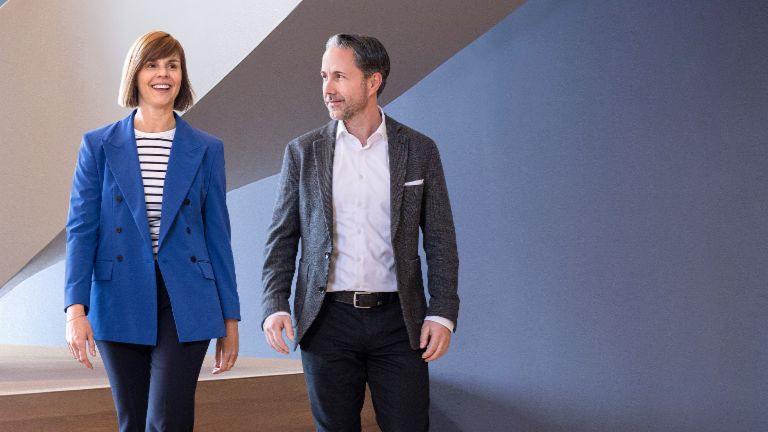Customer centricity and the requirements for receivables management.
Today, receivables managers face new challenges: Customer centricity is becoming increasingly important and demanding, because everything is available everywhere and all the time.
When it comes to the Gen Y and Z target group, lenders and financial service providers are now facing new challenges as they strive to meet this generational cohort’s expectations in respect of flexibility, transparency and freedom. Not only that, this kind of business relationship is ideally supposed to be fun as well.
However, to make the transition from a successful initial approach to young adults to a long-term customer relationship requires extensive adjustments throughout the entire customer journey.
Personalized communication and the usability of the digital services on offer are significant brand hygiene factors when winning new customers and nurturing existing business relationships. Such factors can make the crucial difference for that initial contact with potential customers. It only takes a few seconds for a user to decide: Am I interested in what is being offered? Do I stay on this website or keep clicking?

Because, if young adults want to take out a loan, for example, their journey does not take them directly to their local bank, as would probably still be the case for their parents. Rather, they check out multiple offers online or use comparison websites to find a suitable lender. Generally, young adults tend to want to take out small loans with short terms. This is in keeping with their spirit of flexibility and freedom and a desire to have as few dependent relationships as possible.
Business deals are not just concluded based on facts, figures and data. Rather, the user experience contributes to the entire customer journey: How cool is the banking app and how high its usability? Whereas previously you needed to go to the bank in person to get a loan, now a loan application can be done digitally with an integrated online ID verification process. And what about the visual appeal of the credit card? The bank is becoming a lifestyle brand.
Customer support regardless of business hours and personal contact
To win and keep young adults as customers, the concept of customer convenience is becoming increasingly important. These generations want to handle their banking transactions just as quickly and easily as they’re used to when they shop online or interact with friends: using digital methods and with as few clicks as possible. Offering modern communication channels like messaging services or live chat via the banking app is therefore absolutely essential. Visiting a branch is not even up for discussion.
Nowadays, the smartphone is the device of choice. Across the generations, barely any other device is used to access digital services. Successful companies therefore pursue a “mobile first” strategy.
In this context, the focus is on self-service: Customers do not work around opening hours but want to do their business at a time and place of their choosing. Given this, a chatbot offers a great opportunity as it can provide support outside of normal office hours. At the same time, the personal connection between customer service representatives and customers is becoming increasingly less important and is often not even wanted. And, as you see, customers are turning into users.

Clicks, and as few of them as possible, are becoming the new unit of time
74 percent of users make bank transfers with a banking app. And they want to be able to do this as easily as possible with just a few clicks, in the same way as applying for a loan or managing their ETFs.
Customers expect the same from EOS, so our “EOS Service Portal” platform was developed with a clear focus on user centricity. If someone wants to make a payment there are no technical hurdles to overcome. Instead, EOS has made its user platform clear and simple. Debts can be settled in a matter of seconds with just a few clicks. The simple user prompts result in a lower number of abandoned payment processes, greater customer satisfaction and higher payment receipts.
In addition, the portal makes ten different payment methods available to customers to settle their debt, regardless of income or risk assessments. The use of digital modes of payment in particular is constantly increasing, with one in three users of the EOS service portal now opting for PayPal. In doing so, users are exercising their preference for co-determination and simplicity, without compromising on security and oversight.
Personalized communication with customers in respect of time, space and form
The substance and form of communications with customers also play an important role: Only through individualized, tailored communication does EOS reach your customers and achieve equilibrium in your business relationship with them. Whereas banks previously terminated their relationships with their customers and passed them on to debt collectors, EOS recognizes that the trend is to preserve the business relationship, so that EOS is involved in the process before the termination occurs.
The type of communication includes the contextual approach, which is formulated differently for young adults compared with other generations, as is the communication channel used: Which messaging services do defaulting payers use? At what times, for example, do emails with deep linking reach users and lead to successful payments? All actions are processed via our AI-based collection system, so that the best next step is initiated in real time. The self-learning system guarantees a successful outreach to your customers.
There is also a need to optimize the design and technology used for the digital offering. What is required is a clear, modern layout for websites and apps, which convey the most important messages in a concise and uncluttered way. Input fields and forms are offered directly on the home page, so users know immediately what options are available and what they need to do. Moreover, the digital offering needs to be designed to be responsive, i.e., compatible with every device.
By implementing these requirements every generation is addressed, because for some time now, it has not just been Gen Y and Z that have been the main target groups for digital services.
What role does a company’s own mindset play?
Satisfying these requirements often calls for structural change within an organization. This is why EOS went a step further and decided to implement digital transformation years ago. Since then, EOS has been using solutions like AI with the help of analytics in an agile corporate structure.
For example, EOS lives up to its own aspiration to not just enable consumers and clients to benefit from streamlined processes and systems developed in-house. Instead, it’s about a change that goes to the very heart of EOS: making a company established in 1974 into a dynamic and agile company whose heart beats like a fintech. That is the real art of transformation.
Photo credits: panthermedia, fotolia (2)
Explore more from EOS



-.jpg/jcr:content/___16_7_CEO%20Otto%20Group%20and%20CEO%20EOS%20Group%20in%20Sarajevo%20with%20EOS%20MATRIX%20BA%20(2)%20.13593179161371862035.jpg)